SafeHome.org may receive compensation from some providers listed on this page. Learn More
We may receive compensation from some providers listed on this page. Learn More
SafeHome.org may receive compensation from some providers listed on this page. Learn More
We may receive compensation from some providers listed on this page. Learn More
Experian’s and AAA’s identity theft protection service has everything you need to protect your identity, but it falls short in a few key areas.

Check out more recommendations from the SafeHome team:
Did you know the American Automobile Association, better known as AAA, has been around since 1902? It was founded to advocate the building of roads and highways since there weren’t any suitable at the time for vehicles. Today, AAA organizes emergency road assistance and a range of travel, financial, and insurance services. It even offers a decent identity theft protection product.
Experian and AAA have teamed up to offer AAA customers ProtectMyID. It includes all the essential features you want in an identity theft protection service, such as three-bureau credit monitoring and up to $1 million in insurance. But how does it compare to services like Aura and Identity Guard? We decided to find out. So we signed up and put it to the test. Here’s everything we learned.
ProtectMyID is essentially the same product as IDNotify, as both are powered by credit monitoring bureau Experian. However, similar to what we saw in our review of Complete ID, another Experian-based identity theft protection service available only to Costco Members, ProtectMyID is only available to AAA members. There are minor variations between the three names, but for the most part, the core functionality remains the same across the board.
If this service sounds interesting to you, but you’re not interested in becoming a AAA member to access it, you should consider the stand-alone IDNotify product or Experian’s other service, IdentityWorks.
Did You Know? AAA is actually a federation of motor clubs that provides members with discounts, travel services, and auto shop recommendations.1
Like IdentityWorks, ProtectMyID has three plans available. One of them is even free. Here’s a breakdown of what you get in each plan.
| Service: | Essential | Deluxe | Complete |
|---|---|---|---|
| Credit Monitoring | Single-Bureau | Three-Bureau | Three-Bureau |
| Credit Report | Single-Bureau | Three-Bureau | Three-Bureau |
| Identity Theft Insurance | Up to $10,000 | Up to $1,000,000 | Up to $1,000,000 |
| Fraud Resolution Support | Yes | Yes | Yes |
| VantageScore Tracker | No | Yes | Yes |
| Social Security Number Monitoring | No | Yes | Yes |
| Dark Web Monitoring | Yes – only SSN and email address | Yes | Yes |
| Experian Credit Lock | No | No | Yes |
| Social Media Monitoring | No | No | Yes |
| Sex Offender Monitoring | No | No | Yes |
| Price: | Free for AAA Members | $10.95 Per Month | $17.95 Per Month |
As you can see, there are a ton of useful services available. We chose the Complete plan for the purposes of this review so that we could get into all the bells and whistles, but the Deluxe Plan also offers pretty solid protections. If you’re a AAA member and not interested in spending any extra money on identity theft protection, though, we’d still recommend signing up for the free Essential plan — it’s certainly better than nothing.
>> Learn More: ProtectMyID Plans and Pricing
As mentioned, we decided to go with the Complete plan since it has the most features, and we think the $17.95 monthly price is more than reasonable for what you’re getting.
We were asked to enter our AAA membership number as well as our home zip code to confirm our selection, then we had to do one of those “select all the pictures with trees” verification tests. Finally, we were asked if we wanted to be billed on a monthly or an annual cycle. So keep in mind that if you decide to go annual, you’ll save a little over $30 per year on the Platinum plan.
Next, we had to create our account. This was simple enough — we just had to enter our personal information like our name, our address, our date of birth, and our Social Security Number. We were also asked to enter our email address, create a password, and select a security question and response.
Now, if you’ll let us hop up on our soapbox here for a second, we’d like to say a little something about passwords. First, your password needs to be at least eight characters long and include capital and lowercase letters as well as numbers and special punctuation. Do not use anything identifiable like children’s birthdays or the name of the service the password is for. Ideally, you’ll use a password manager to generate something completely unique and random.2
Luckily, ProtectMyID’s minimum requirements will force you to create a fairly secure password, which we really liked seeing. Just make sure you’re not using common words or phrases.
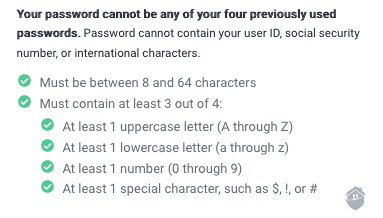
ProtectMyID Password Standards
Once that was done, we only had to enter our billing information, and we were all set. No real hurdles to jump and no headaches to deal with. Kudos to ProtectMyID, here. This sign-up process was pain-free. On to setting up our services!
After purchasing a Complete subscription, we had to enter the information we wanted ProtectMyID to monitor. This involved a series of questions, including where we held mortgages, when we applied for auto loans, and what social media accounts we had. It sounds easy, but some of these questions can be a little tough. Be sure to read through all the responses carefully before you answer so you don’t have to restart the process later.
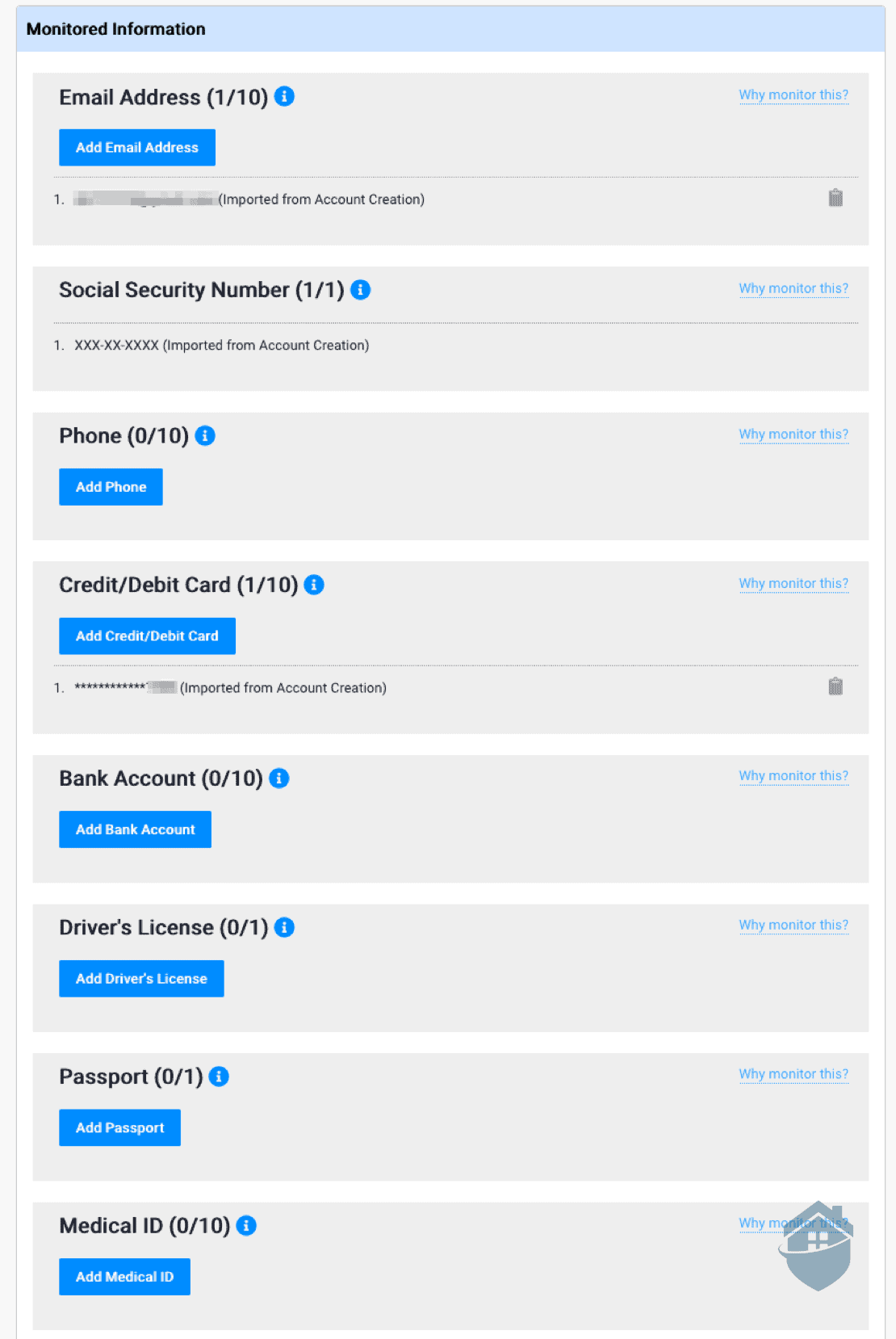
ProtectMyID Monitored Information
We’re going to hit pause really quick to point something out. We were a little disappointed in ProtectMyID’s resources at this point. Hovering over “why monitor this?” doesn’t really provide any useful information. For each category, it simply says “We monitor your *insert piece of information here* so we can notify you if we find a match to it online.” Where online? How do you monitor it?
When we reviewed IDX and other brands, we typically found really detailed explanations of how and why things were being asked for and what was happening with the information. We think ProtectMyID should offer more meaningful detail here, or just leave it off altogether.

ProtectMyID Monitoring Explanation
This initial setup might seem like a tedious process, but you should enter everything you have to make the most of the monitoring services. Identity theft is insidious. You never know which pieces of your information a fraudster is using to build a fake persona that could decimate you financially.
After that was done, we were asked if we wanted to enroll any children in our protections. The Complete plan lets you monitor up to 10 for no additional cost.
FYI: The Complete plan is the only ProtectMyID option that lets you add children at no extra cost. You can subscribe to the Deluxe package, but it will cost you an extra $3.95 per month.
We don’t have any little ones of our own, but for those who do, this is an important option to consider. Although they don’t have established credit histories or financial information of their own, children are viewed by identity thieves as blank slates. What’s worse, fraud committed in children’s names often goes undetected for years.3 If you’re interested in identity theft protection for your entire family, read our guide on the best identity theft protection services for children.

Welcome to ProtectMyID
We’ve reviewed quite a few identity theft protection services, but we still always like it when they walk us through the setup. When we tested NortonLifeLock, we got a little overwhelmed with all the features included in our subscription. Some guidance or orientation would have made it a little easier to navigate.
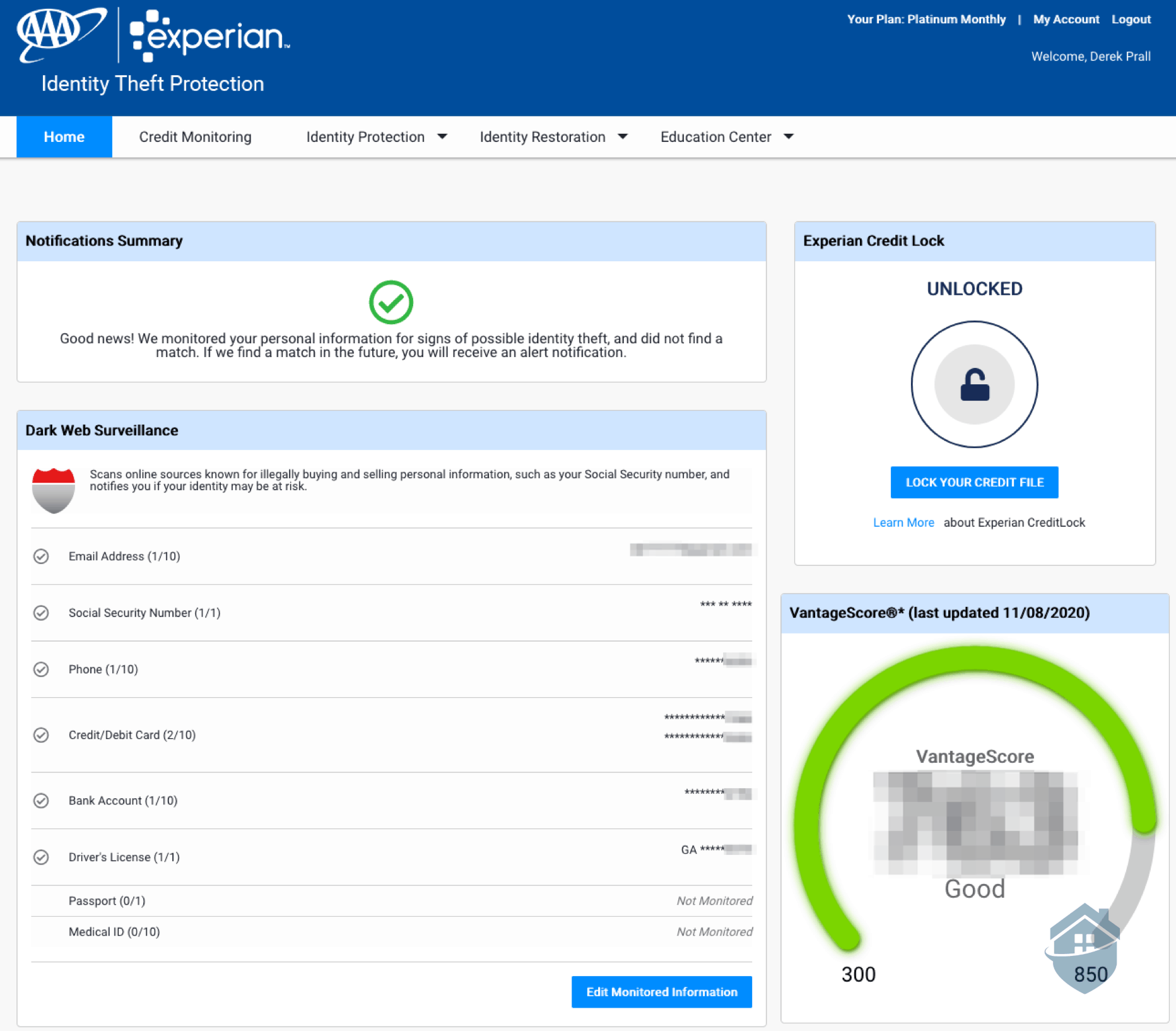
ProtectMyID Dashboard
We weren’t underwhelmed by ProtectMyID’s dashboard. Everything we needed was accessible on the home page, and it was easy to switch between the monitoring services and the identity protection tools. While we’re on the topic of these features, let’s take a look to see how they performed.
Experian’s credit lock tool is the first thing we checked out. The tool is exclusive to ProtectMyID’s Complete service, but we’ve seen similar functionality elsewhere.
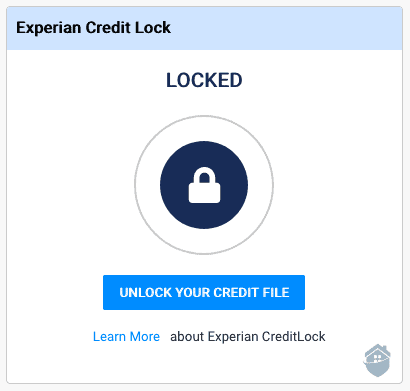
ProtectMyID Credit Lock
Both locks and freezes essentially accomplish the same thing. They prevent unauthorized individuals from applying for lines of credit or loans using your credit files by blocking all activity associated with them. Locks — like the one offered by ProtectMyID — are able to be toggled on and off in real-time, while freezes take a little more effort to set up and undo.
FYI: We recommend everyone keep their credit files locked or frozen. To learn more about how to do that, we suggest visiting each bureau’s website.
The next feature we checked out was our VantageScore tracking. To understand how this is helpful, first you have to understand what VantageScore is.
When most people think of a credit score, what they’re actually thinking about is their FICO score. FICO was a general-purpose score introduced by the Fair Isaac Corporation in 1989 to determine an individual’s creditworthiness. VantageScore, on the other hand, was developed in 2006 by the three major credit reporting bureaus. It’s calculated using a different model than the FICO score and is growing in popularity among lenders as the score of primary importance.4
Did You Know? Your VantageScore and FICO scores can vary dramatically. It’s good to keep an eye on both.
Next on the list was taking a look at our credit reports. As expected, our Experian credit score was readily available but we could also send requests for reports from Equifax and TransUnion. Here’s a quick rundown of what we could sift through in the Experian report:
We were also able to set alert preferences in regard to our credit score — this is a pretty unique feature we haven’t seen offered by many other companies, and one we think would really come in handy for anyone looking to recover after financial hardship.
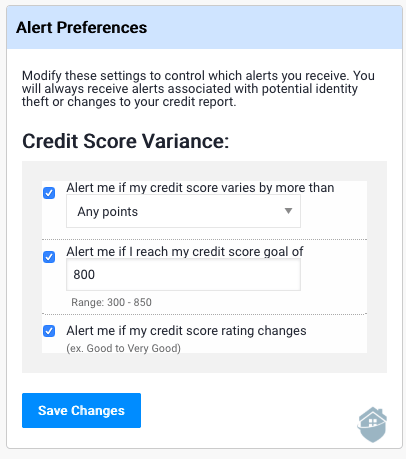
ProtectMyID Alert Preferences
Now that we had our credit monitoring organized, it was time to look at our dark web surveillance report.
Did You Know? The dark web is only accessible from certain browsers. It’s estimated that the deep and dark web combined is 500 times the size of our day-to-day surface-level internet.5
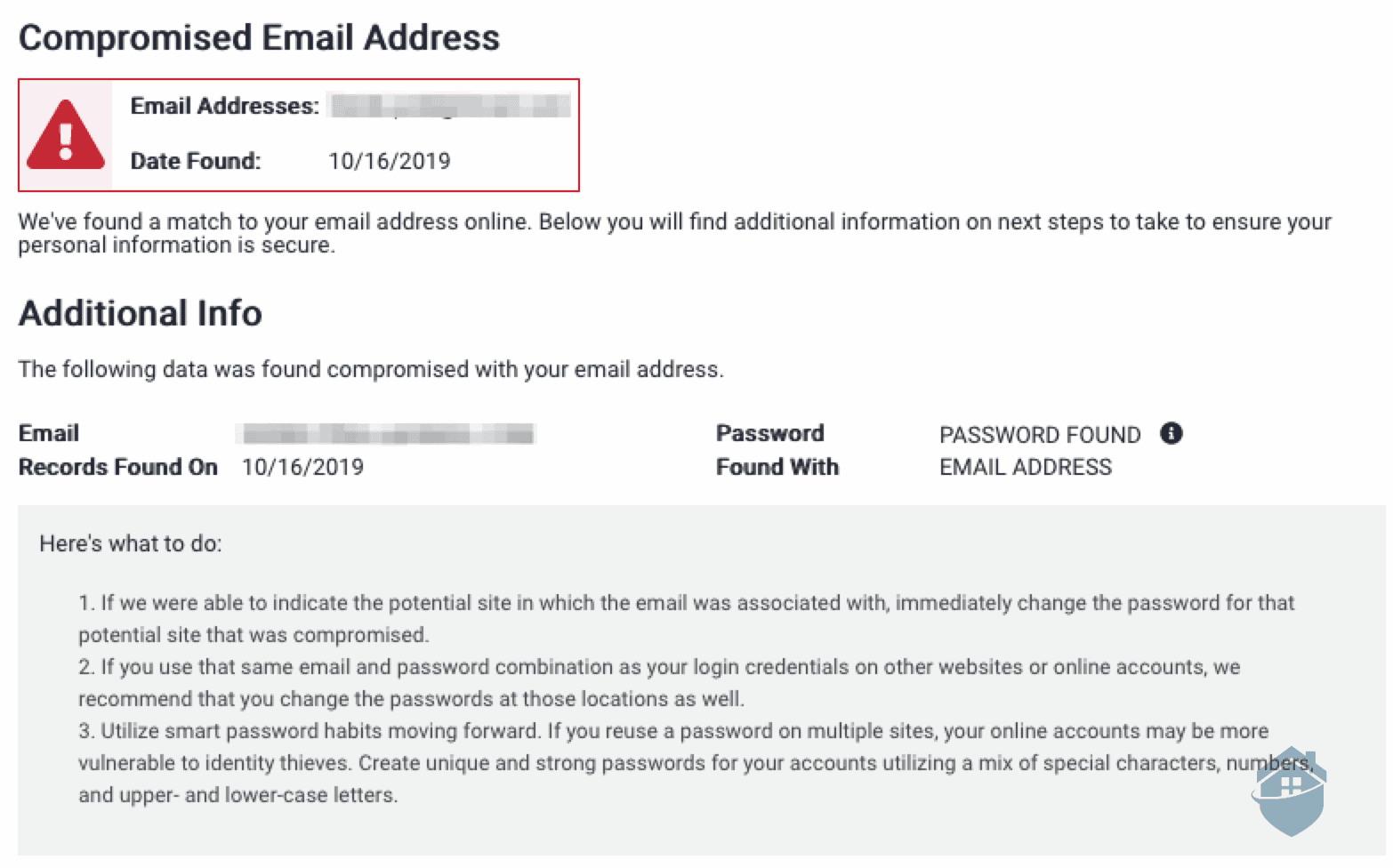
ProtectMyID – Compromised Email
We loved the detail here, and the actionable notifications. Similar to what we saw when we tested Identity Guard, ProtectMyId provides us with plenty of information to make an appropriate decision based on the items they turned up. Lucky for us, all of the hits they found were old, and we’ve since changed all of our login information. If your report turns up something recent and you’re still using the same credentials, you should go ahead and change it ASAP.
FYI: There’s no need to panic if this report comes back with a lot of hits. With the numerous high-level breaches that have occurred over the past few years, it’s very likely bits and pieces of your information are going to show up on these types of scans.
We also really liked ProtectMyID’s Social Security Number monitoring feature. With other services, we’ve found this functionality isn’t very robust, but here we received really detailed information on how our Social Security Number was being used, where, and by whom. There was even a map to help us visualize where ProtectMyID found pings.
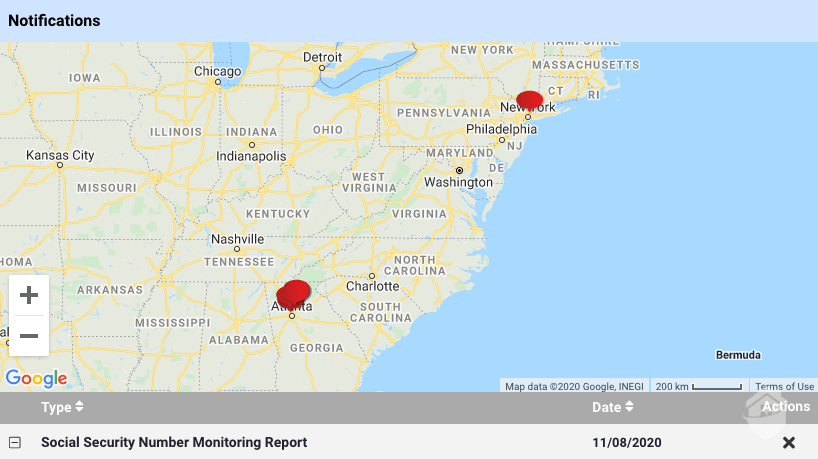
ProtectMyID Social Security Number monitoring notifications
Similar to ProtectMyID’s dark web monitoring, there’s no cause for alarm if there are alerts in this report. What you want to look out for are names you don’t recognize or locations that don’t make sense.
Moving on, though, we were a little disappointed in the sex offender monitoring. Like so many other identity theft solutions we’ve used, this functionality in ProtectMyId’s suite of services just didn’t seem to work correctly.
The monitoring purports to “provide a list of sex offenders living in your area, and notifies you if an offender tries to register with your identity.” Our report turned up nothing. That would be good news if we didn’t know for a fact there were several sex offenders living in our area.
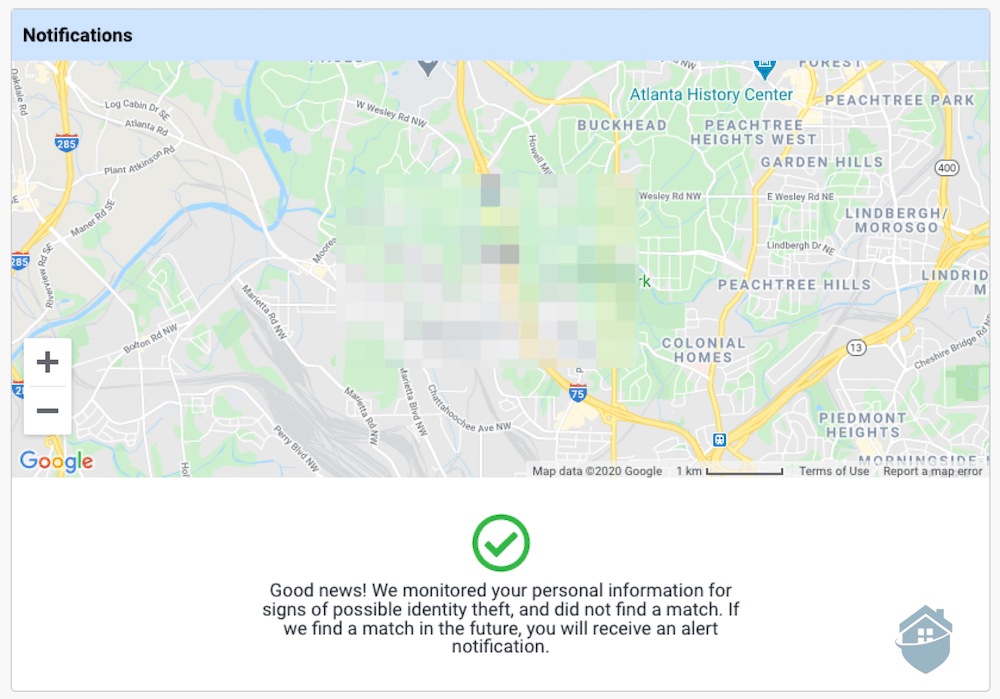
ProtectMyID Personal Information Notifications
If this service is extremely important to you, then we can’t recommend ProtectMyID.
Let’s conclude on a positive note, though. ProtectMyID does offer an insightful Education Center where you can learn all about credit scores, credit monitoring, and protecting yourself from identity theft. To be honest, this trove of resources alone was well worth the price of admission.

ProtectMyID Credit Report Articles
Credit monitoring and identity theft protection can be daunting, and it helps to have resources at our fingertips to help us understand the nuances of what exactly the service is (or isn’t) doing. Major bonus points for ProtectMyID, there.
So what’s the takeaway here? In our estimation, ProtectMyID is a great service for folks who already have AAA membership. We wouldn’t go out of our way to purchase AAA’s service just to have access to ProtectMyID — like we said, IDNotify and IdentityWorks are available to everyone — but if you’re already a AAA member, it’s certainly worth looking into.
We loved the number of features that were available under the Complete plan, and everything worked really well for the most part. We wish there was more than one that includes kids for free, but other than that, the protection and monitoring felt complete. In all, we’d say this is a great addition for consumers who are already protecting themselves out on the road.
ProtectMyID is operated by one of the major credit bureaus, Experian, and offered to all AAA members.
Every ProtectMyID plan includes credit and identity monitoring services. If any suspicious activity is detected on credit files, the dark web, or social media, you’ll receive an alert. ProtectMyID also monitors the use of your Social Security Number and personal details in loan applications.
Yes, it is. To date, there have been no reports of data breaches for ProtectMyID customers.
Both ProtectMyID and IdentityWorks are run by Experian. However, the main difference is that ProtectMyID plans are cheaper and only available to AAA members.
Only ProtectMyID’s Essential plan is free. It includes some basic features such as Experian credit monitoring and a dark web surveillance report. But we recommend upgrading to a paid plan for extra identity monitoring and three-bureau credit monitoring.
Rossi, A. (2018, August 24). 12 AAA Travel Benefits You Probably Never Considered. Smarter Travel.
https://www.smartertravel.com/aaa-travel-benefits/
Empey, C. (2018, August 15). How to Create a Strong Password. Avast Blog.
https://blog.avast.com/strong-password-ideas
CNBC. (2024, August 23). Why parents may want to start locking a child’s credit at a very young age.
https://www.cnbc.com/2024/08/23/identity-theft-of-americas-youngest-generation-is-on-the-rise.html
Bryant, S. (2020, October 10). What you should know about the VantageScore 3.0 credit scoring model. Credit Karma.
https://www.creditkarma.com/credit-cards/i/vantagescore-30
Peek, K. (2015, April 1). Most Of The Web Is Invisible To Google. Here's What It Contains. Popular Science.
https://www.popsci.com/dark-web-revealed/